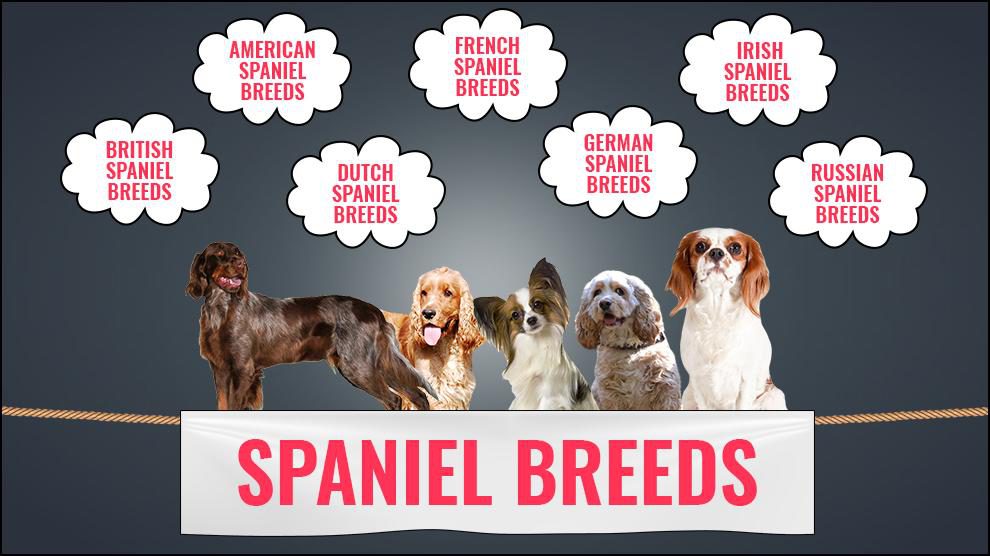Dog Pregnancy Calculator And Timeline
Small to medium in size, silky, long and wavy hair, big floppy ears, ridiculously adorable puppy dog eyes, admirable noses and soft mouths—these descriptions of a hunting dog appeared in literature hundreds of years before the Christian era.
Throughout history, several spaniels were recognized to meet evolving hunting needs. Nowadays, when determining which spaniel best fits their needs, modern pheasant hunters have a few different options.
There are almost 25 recognized breeds of Spaniels and there are several spaniel variants. However, most trainers and breeders agree any spaniel will perform its primary objective—flushing out games—only style, technique, temperaments and physical traits, vary from breed to breed.
What Spaniels are known for is their unremitting, “all business” attitude with eyes always on the prize.
Did we mention how loving and devoted they are? They love their humans from the word go.
It is impossible to forget a spaniel’s eyes, it is so gosh-darn memorable. In any case, this is an understatement according to spaniel breed lovers!
British Spaniel Breeds
Most spaniel types and breeds were developed within the UK. They were popular with the aristocrats and common people, both as hunting assistants and companions.
In due course, however, some British spaniel breeds have low annual registration number statistics and become vulnerable to extinction. Let’s have a run-down of the top Spaniel breeds native to the UK that is still around today.
1. Cavalier King Charles Spaniel
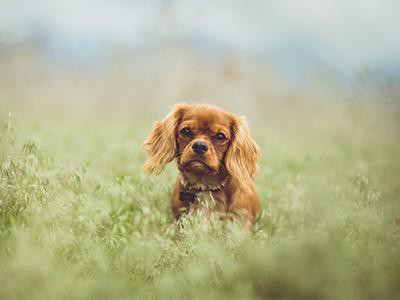
Highlights: Active, Affectionate, adaptable, playful, smart and extremely loyal
Classed as a toy dog by The Kennel Club, this British spaniel breed is extremely popular. It is one of the smallest Spaniel breeds at 30-33 cm (12-13 in) tall.
These small spaniel breeds come in different color combinations, but most commonly in shades of brown. Cavie spaniels are a good choice for first-time dog owners because they are trainable dogs.
These dogs are very eager to please and they thrive on being in a home environment.
2. King Charles Spaniel
Highlights: Active, Affectionate, adaptable, playful, smart and extremely loyal
Cavalier King Charles spaniel and King Charles spaniel are different toy spaniels; King Charles Spaniel is also known as the English toy spaniel. Both share the same origin and have a lot in common as well as several noteworthy differences.
They appeared in the 16th Century and were popular in the English court for centuries. There is, in fact, a famous royal spaniel called Dash or Dashy that was Queen Victoria’s closest childhood companion.
The English toy spaniels are slightly larger than Cavalier King Charles spaniels. Cavie spaniels have a slightly large head and muzzle.
Long, silky fur that should always be straight with no curling or waves, on the other hand, the English toy spaniels have proportionate heads with a notably short muzzle and have a slight wave to their coats.
Both are highly affectionate lap dogs that are loyal and playful with quiet and stable temperaments (the reason why both dogs were classed as the same breed only a century ago).
They are also intelligent dogs, and especially, they don’t have the obsessive working drive of many other spaniels and are not overly demanding in terms of their need for exercise and activities.
3. Clumber Spaniel
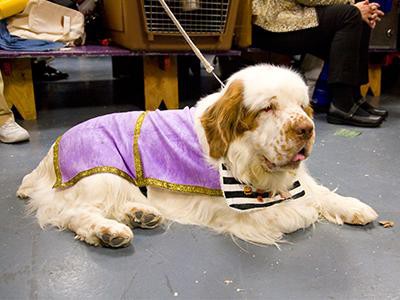
Highlights: Active, adaptable, Easygoing, outdoorsy, strong, loyal, trainable
This “mellow and dignified hunting companion of the kings” was a favorite with the royal family for many decades and they hail from Clumber Park in Nottinghamshire.
It’s among the largest spaniel breeds (they grow to 43-52 cm (17-21 in) tall) and is considered to be strong, defiant and well-known for their superior scenting abilities.
This muscular and sturdy breed is built to shove through covers in harsh terrains to hunt game birds, ensuing a “clumber gait” hence they got their name, “Clumber Spaniel”.
Unfortunately, these days the Clumber spaniel is a vulnerable native breed in the British Isles.
4. English Cocker Spaniel
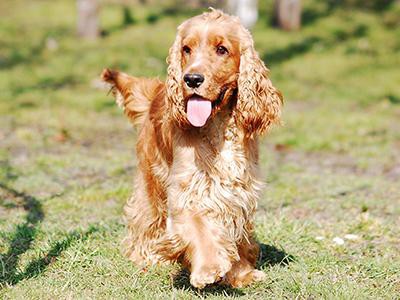
Highlights: Alert and active, clever, cheerful, trainable, family-oriented
Known as just “Cocker Spaniel” in America, English Cocker Spaniels are one of the most popular companion Spaniel breeds in Great Britain.
The name “cocker” comes from the fact that these dogs are used in hunting bulky, wading birds ‘woodcocks’ that reside in dense woodlands. English cockers are divided into two different breed types: working and showing.
The conformation of these types can appear quite different in terms of size and build. The difference between English Cocker spaniels and their American counterparts is the size as English spaniels are larger and taller while American Cockers have a longer and more voluminous coat.
5. English Springer Spaniel
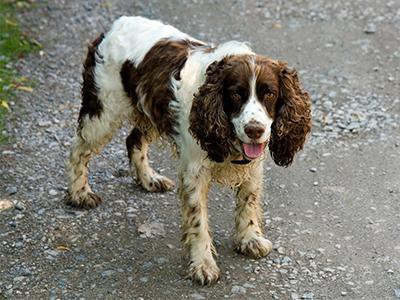
Highlights: Friendly, obedient, loyal, alert, active, energetic, trainable and used in police departments
Bred in the 19th Century, this slightly larger breed descends from the original Shropshire and Norfolk Spaniels.
The English Springer Spaniels is one of the two Springer variants ( the other one is the Welsh Springer Spaniel) and is considered to be closely related to the Cocker Spaniel.
The working Springer spaniels are with coarser and shorter coats while those meant for shows, with big ears and soft coats. Originally bred as a gun dog, they are now used as police dogs, sniffers, rescue dogs and in dog sports.
6. Welsh Springer Spaniel
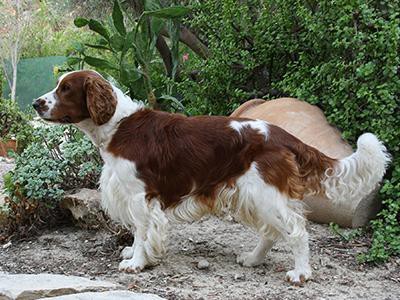
Highlights: Alert, active, energetic, friendly, obedient, loyal, trainable
Also known as the Welsh Cocker Spaniel, this breed was almost extinct and came back to existence due to the work of some breed enthusiasts who re-bred them in the middle of 20th Century.
As already mentioned, the Welsh springer spaniel is one of the Springer variant and only dog experts or true Springer enthusiasts can tell the difference between the variants at a glance!
They are not as common as the English Springer and are generally slightly less stocky and shorter than the English Springer. Another difference is its coloration – brown on white coat typically having a predominant red hue to the brown patches.
7. Field Spaniel
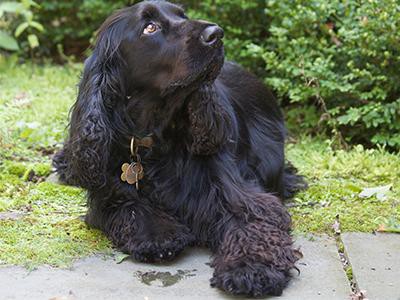
Highlights: Active, energetic, intelligent, independent, patient, trainable, Friendly
Unlike most UK spaniel breeds, Field Spaniels are particularly used as ‘show dogs’, however, they were popularly used as a retrieving dog in earlier times.
Although they are still equally adept at hunting, breeders have turned this into more of a companion dog and are rarely make into the hunting parties. Although they are very sensitive, their sweet disposition makes them ideal as pets and companions
8. Sussex Spaniel
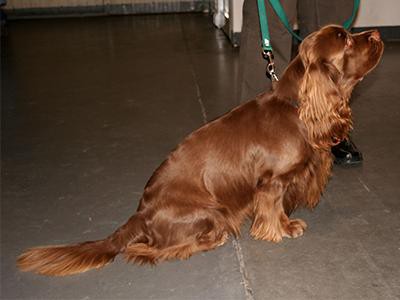
Highlights: Calm, tolerant, Sociable, Patient, Friendly, trainable
As a part of a melange of land spaniels, this southern British breed was bred in Sussex in the late 18th century.
They resemble the Clumber spaniel, though they are a comparatively smaller spaniel breed and but has a coat with the distinctive gold/liver colored shade that is not found in any other breed.
Sadly, they are considered as a vulnerable native spaniel breed with just 60 Sussex Spaniels registered during 2009.
Sussex Spaniels have an excellent scenting ability. They are patient, composed and family-oriented, which makes them quieter than other more excitable types of spaniels.
American Spaniel Breeds
1. American Cocker Spaniel
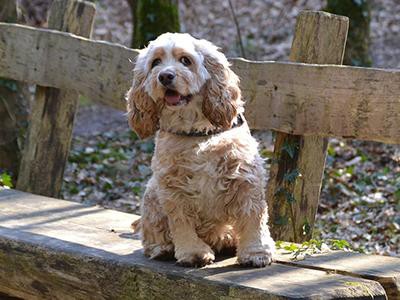
Highlights: Alert, fun-loving, cheerful, active, clever, smart, and trainable
As mentioned earlier, the American Cocker Spaniel and the English Cocker Spaniel are very similar, as they only differ in size and coats.
The size of the head is the main difference between them, as the American variant has a domed skull, flatter muzzle, and noticeable eyebrows.
Affectionately referred to as “Cockers”, the Cocker Spaniels are great with children and pets, and with proper socialization, they can get along with almost anyone.
2. American Water Spaniel
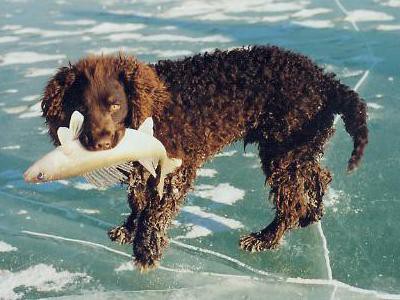
Highlights: Agile, versatile, resistant, cheerful, intelligent, sometimes stubborn
This American spaniel breed descends from the now extinct English Water Spaniel and Irish Water Spaniel.
First bred in Wisconsin in the 19th Century, they are particularly popular in the lake country of the Upper Midwest where its dense waterproof coat and thickly padded feet, as well as webbed toes, allowed it to hunt and swim in cold weather.
They are equally good in warm climates, make for decent jogging partners and affectionate family pets.
3. Boykin Spaniel
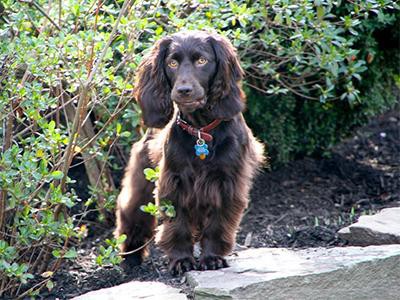
Highlights: Agile, cheerful, intelligent, friendly, inquisitive, steadfast
This spaniel breed with a native of South Carolina was bred specifically to hunt turkey.
Since their native land was quite swampy and only small boats were used with little room for big retrievers, this new spaniel was bred to be a good swimmer of small size.
He is a water dog par excellence but not much of a watchdog, but if you’re looking for a buddy for boating, hiking or hunting, he’s a great choice.
Dutch Spaniel Breeds
1. Drentse Patrisjhond Spaniel
Highlights: Agile, determined, loving, friendly, reliable, willful, trainable
The name of this old gun dog breed comes from the word “Drent”, meaning “partridge” so it is called Dutch Partridge Dog.
They are also known as Dutch Gundog, Drent and the Drentse Partridge Dog This medium-sized spaniel was bred in the 16th Century to hunt partridges, vermin, fowl and other game in Holland and its neighboring countries.
This Dutch Partridge Dog was most human-dependent hunting dog though they instinctively know how to hunt, flush and retrieve. They are also trainable in all sorts of purposes.
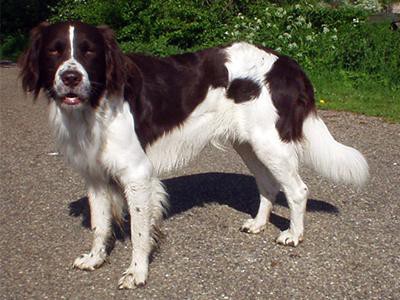
Dutch Gundogs are determined, reliable and very steadfast dogs who can run quite fast. In the past, the breed was more multipurpose and served as vermin slayer, used to pull carts and a draft animal.
The modern breed is primarily a gundog and is commonly used as non-working household pets. They are one of the most popular working gundogs in the Netherlands but they remain rare elsewhere in the world.
2. Kooikerhondje Spaniel
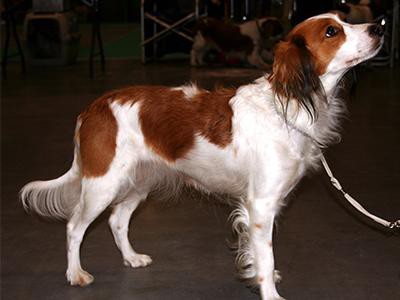
Highlights: Agile, confident, curious, intelligent, sensitive, watchful, trainable
This adaptable Dutch spaniel has a weird name (and good luck for pronouncing it) and they were originally bred to work in farms.
They are often referred to as Dutch decoy dogs as they were developed to work in duck decoys. This Dutch spaniel breed is cheerful, sociable and dutiful; however, it can be suspicious of strangers, as it is very alert.
This breed is believed to be a predecessor to the Nova Scotia Duck Tolling Retriever. They nearly went extinct at the start of the 20th century, but Baroness van Hardenbroek revived them in 1939.
3. Markiesje Spaniel
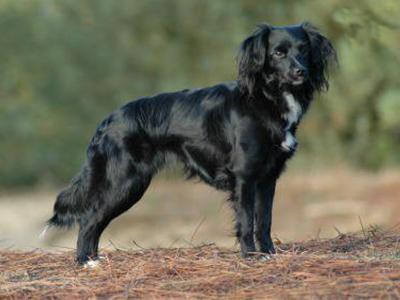
Highlights: Alert, determined, loving, friendly, Watchful, trainable
The origins of this Dutch spaniel, also known as the Dutch Tulip Hound (or the Hollandse Tulphond) goes way back. However, the Markiesje Spaniel as we know it in modern days was bred just decades ago.
This breed is in the stage of reconstruction and they were accepted as the official Dutch Breed of companion dog only in 2009.
They are called spanjooltjes in popular speech and they were considered a “non-useable” small dog when it came to hunting purposes.
Also labeled as a non-purebred lapdog for the women, The Markiesje is a slightly stretched black dog and their size is the same as the Kooiker Spaniel.
The Markiesje Spaniel is an alert, vigilant dog that can be an excellent keeper dog and gets along well with children and other pets.
4. Stabyhoun Spaniel
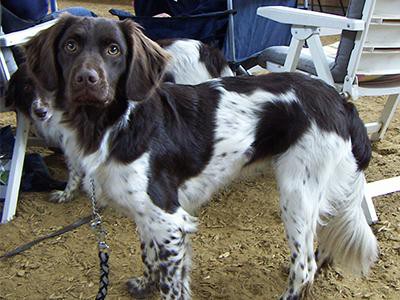
Highlights: Alert, even-tempered, Adaptable, obedient, Watchful
Unfortunately, the Stabyhoun Spaniel is a very rare Spaniel breed. It looks similar to the English springer spaniel but can be used both as a soft-mouthed retriever and pointer dog.
The Stabyhoun originated in Friesland -an area in the northern Netherlands and its name ‘Stabyhoun’- is derived from the Frisian words “sta-me-bij” meaning “stand by me”.
It was used in Friesland farms as a farm dog to catch vermin, hunting (ducks and upland birds) and drag carts. The Stabyhoun Spaniel is extremely useful as a retriever dog, as it never damages or hurts what it catches.
This beautiful black-and-white breed is tolerant and has a gentle disposition, so they are kid-friendly although they do have an independent streak. They make excellent guard dogs.
They tend to have good health and long lives, which explains the recent surge in interest for this breed.
French Spaniel Breeds
1. French Spaniel (Épagneul Français)
Highlights: Alert, even-tempered, caring, obedient, loyal, trainable
The French Spaniel is the oldest spaniel breed in France with its history extending back through the courts of nobility in medieval France and Europe.
This Spaniel breed was bred from Portuguese and Spanish hunting dogs of the Middle Ages. It’s been referred by the names of “French Setter” and “Canada Setter” (as it is also bred in Canada).
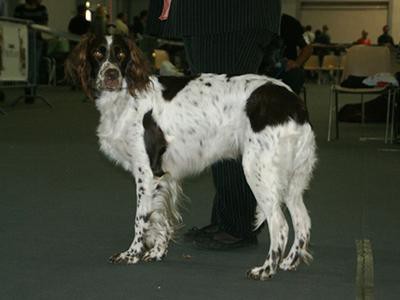
They were used to flush out wildfowl in woods and have the good scenting ability for tracking
2. Papillon And Phalène Spaniels (Epagneul Nain or Dwarf Spaniel)
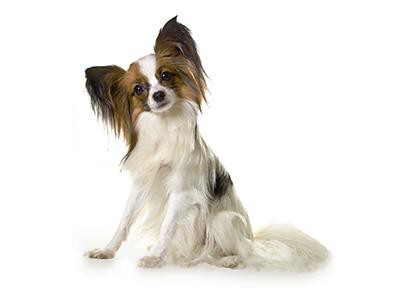
Highlights: Alert, affectionate, even-tempered, caring, obedient, watchful, trainable
This old French breed is also called “Continental Toy Spaniel or European Toy Spaniel”. Their name, “Papillon” means “butterfly” and “Phalene” means “moth”.
Phalene is a variant of the more popular Papillon and they are grouped under the same breed (but the FCI classifies both as separate breeds), differing only in their ear carriage.
Phalene Spaniels are considered to be the predecessor of papillon. While the exact origin of these breeds is difficult to be sure about but we can see them represented in some Renaissance Paintings in the 16th century.
They were popular dogs among the higher classes and were primarily used for companionship. It is speculated that the Phalene naturally gave rise to the papillon, a variety with symmetrical, erect ears was bred.
Both the breeds come in many different colors and they are sensitive to the cold as they only have a single coat. They make good watchdogs and may even resort to mild aggression to bark away from the intruders.
3. Picardy Spaniel (Épagneul Picard)
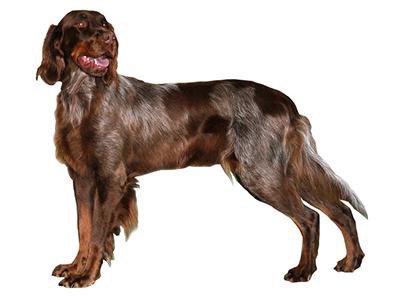
Highlights: Active, affectionate, Companionable, docile, energetic, trainable
Together with the French Spaniel, The Picardy Spaniel is among the oldest of all French spaniel breeds, though, nowadays they are considered as a rare breed.
The Picardy Spaniel was said to be bred by ‘by hunters for hunters’. This is an adaptable, fast gun dog; prized for hunting, pointing, and retrieving in different terrains, from marshes, swamps to woods.
Picardy Spaniels makes for a great family pet, though it may not be appropriate for first-time owners
4. Blue Picardy Spaniel (Épagneul bleu de Picardie)
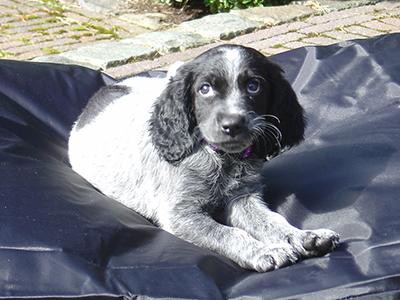
Highlights: Active, affectionate, Companionable, docile, energetic, trainable
This rare Spaniel breed appeared in France, in northern France around the river Somme region.
Experts believe that the Blue Picardy Spaniel was likely a descendant of crosses between the Picardy Spaniel and the English setter, although there were perhaps influences from some local types of French dogs.
Its name comes from its soft, wavy bluish-gray coat with black patches.
5. Pont-Audemer Spaniel (Épagneul Pont-Audemer)
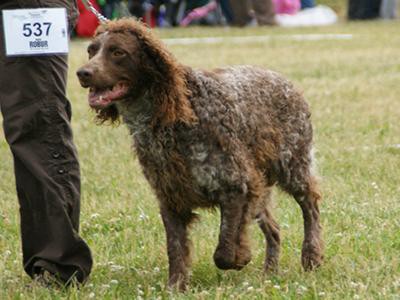
Highlights: Active, vigorous, resilient, out-going, energetic, trainable
One of the most unusual Continental spaniel breeds descends from the Picardy spaniel and possibly the Barbet, as well as the Poodle and its creators, also bred their dogs to English and Irish Water Spaniels resulting in a breed with a unique look and hunting style.
They are named after the small city of Pont-Audemer, in Normandy region in north-western France. The ‘Ponto’ as it is affectionately called is a fun-loving and affectionate breed.
This “clown of the marsh” enjoyed a good reputation amongst waterfowlers. The Pontos are on a verge of extinction and there are only less than 1000 of them in the entire world.
German Spaniel Breeds
German Spaniel (Deutscher Wachtelhund)
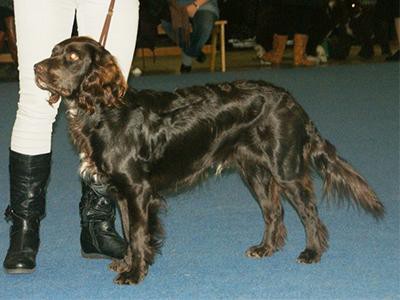
Highlights: Active, brave, resilient, determined, energetic, trainable
This multifunctional German spaniel breed name means “quail”, as this German Spaniel was used to hunt quails in harsh weather conditions.
Descended from the old German breed, the Stoeberer, The breed is not so popular outside of Germany and was recognized by the UKC only in 1996.
They are basically flushers, make excellent bird dogs, work fur game and they are noted for going in for the kill. They may be aggressive in the hunt, but they are a loyal and affectionate family dog, and friendly with kids.
Irish Spaniel Breeds
Irish Water Spaniel (IWS, An Spáinnéar Uisce)
Highlights: Active, good-natured, friendly, energetic, playful, vigilant, trainable
Often mistaken for a large brown poodle dog, this native Irish water spaniel breed has an unbelievably long history and they appear in folklore and legends.
Though they are called a spaniel, they look extraordinarily different from all the other types of spaniel. They are the tallest of all the Spaniels (56-61 cm (22-24 in) tall).
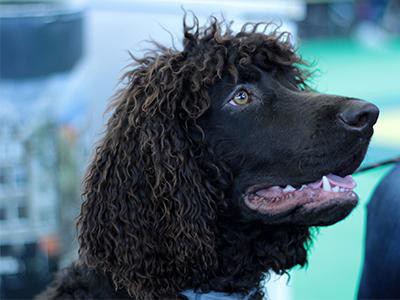
The Irish Water Spaniel are excellent swimmers (they even have webbed feet). They are primarily a water retriever used in retrieving waterfowl as well as upland game such as pheasant, quail, and grouse.
Irish Water Spaniel barely sheds, so it’s often included in hypoallergenic dog lists. Irish Water Spaniel is very clever and is eager to please their masters. Unlike most other spaniel breeds they make great watchdogs as they have a very deep and distinct bark.
Russian Spaniel Breeds
Russian Spaniel (Rosyjski)
Highlights: Active, easy-going, friendly, joyful, vigilant, trainable
The Russian Spaniel was developed in the Soviet Union in the mid-20th Century. They are used for flushing prey and to hunt quail, corncrake, and sandpiper.
Similar in appearance to the English springer spaniel and English Cocker Spaniel, they differ from them only when it comes to small details such as longer limbs, sleeker ears, and shorter fur.
It was used to navigate in difficult terrains like woodlands and marshes in harsh weather conditions.
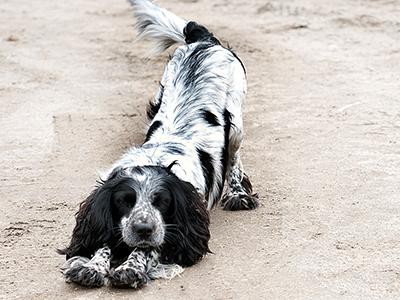
While not currently recognized by any major kennel clubs, they are currently very popular pets in Russia. Known for its friendly and sweet nature, they are kid-friendly due to its high tolerance of children and desire to play.
The History Of Spaniel Breeds
Spaniels are speculated to go as far back as the 13th century though; their ancestral breeds are thought to go hundreds of years even further.
It is widely assumed the spaniel owes its roots to Spain, though theories vary regarding its method and date of arrival in the British Isles.
However, the origin of the word is attributed to the Old French word “Espaigneul” that means “Spanish dog”.
Starting around the year 1,000 B.C., there are several paintings in the British Isles which include a Spaniel type dog referred to as Hunting Spaniels.
The most popular theory is they were brought to the British Isles by Celts migrating from Spain. Another theory is that the Romans brought them to the British Isles and they called these dogs as the “Agassian Hunting Dogs”.
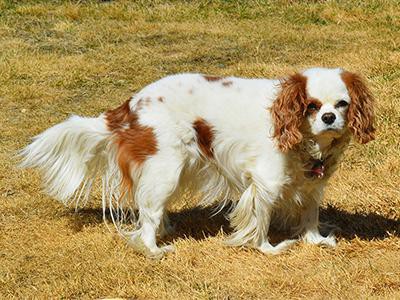
Only after the 17th century, Spaniels were divided into different categories.
Land or field spaniels are land game retrievers that used for hunting in the field. The dog’s job is to force a bird out from bushes or its nest and so the trained bird of prey (hawks or eagles) can swoop down, snatch and take them to their falconer (falconry).
As for water spaniels, they hunt birds upon water ducks, drakes, waterfowls, etc. These dogs are also used as “Searchers” and “Finders” as they were used to bring the arrows out of the water that has missed their mark and the lost shafts.

